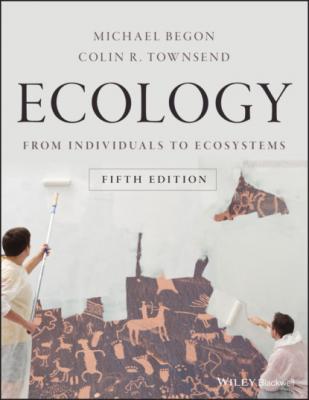Ecology. Michael Begon
Читать онлайн.| Название | Ecology |
|---|---|
| Автор произведения | Michael Begon |
| Жанр | Биология |
| Серия | |
| Издательство | Биология |
| Год выпуска | 0 |
| isbn | 9781119279310 |
Figure 3.19 Bioengineering of a gene from cyanobacteria into soybean increases its rate of photosynthesis. A comparison of soybean (Glycine max) wild type (blue) and a variety genetically engineered to express the cyanobacterial membrane protein ictB (red) in terms of the effect of a plant’s internal CO2 ([CO2i]) concentration on its net rate of photosynthesis (Anet). The fitted lines were non‐rectangular hyperbolas reflecting current understanding of the underlying physiology.
Source: After Hay et al. (2017).
the evolution of C4 and CAM
The evolution of the C4 and CAM pathways, and of CCMs generally (that increase the concentration of CO2 around RuBisCO), has been reviewed by Raven et al. (2008). They describe the very strong evidence that these mechanisms are evolutionarily primitive (the earliest appearing at least 300 million years ago) but also that the C4 and CAM systems must have arisen repeatedly and independently during the evolution of the plant kingdom – the most recent being the appearance of C4 in land plants only 20–30 million years ago. This prolonged coexistence of multiple paths to carbon fixation foreshadows a pattern we will see many more times in later chapters – of coexisting species utilising the same resources but in different ways.
3.4.2 The response of plants to changing atmospheric concentrations of CO2
Of all the various resources required by plants, CO2 is the only one that is increasing on a global scale. This rise is strongly correlated with the increased rate of consumption of fossil fuels and the clearing of forests. As Loladze (2002) points out, while consequential changes to global climate may be controversial in some quarters, marked increases in CO2 concentration itself are not. High mixing rates in the atmosphere mean that these are changes that will affect all plants. Plants now are experiencing around a 30% higher concentration compared with the preindustrial period – effectively instantaneous on a geological timescale. Trees living now may experience a doubling in concentration over their lifetimes – effectively instantaneous on an evolutionary timescale.
changes in geological time
Putting this in a wider context, though, there is also evidence of large‐scale changes in atmospheric CO2 over much longer timescales. A range of models suggest that during the Triassic, Jurassic and Cretaceous periods (around 250–70 million years ago), atmospheric concentrations of CO2 were four to eight times greater than at present (and both lower and very much higher prior to that), falling after the Cretaceous from between 1500 and 3000 μl l−1 to below 1000 μl l−1 in the subsequent Eocene, Miocene and Pliocene, and fluctuating between 180 and 280 μl l−1 during more recent glacial and interglacial periods (the last 400 000 years; Figure 3.20). The steady rise in CO2 since the Industrial Revolution is therefore a partial return to pre‐Pleistocene conditions, more than 2.5 million years ago.
Figure 3.20 Estimates of atmospheric CO2concentrations over the past 600 million years (Ma). The red line (with estimated range of error in pink) is the output of the GEOCARB III model, which uses estimates of rates of geological weathering, emission and burial modified by a range of factors including global temperature and continental size. The blue line is the result of averaging four proxies of CO2 concentrations, including isotopic compositions of minerals and plankton and the distribution of stomata in plant leaves.
Source: After Royer et al. (2004).
what will be the consequences of current rises?
When other resources are present at adequate levels, additional CO2 scarcely influences the rate of photosynthesis of C4 plants but it increases the rate for C3 plants. As atmospheric concentrations continue to rise, therefore, it is no surprise that there has been considerable interest in the effects of higher CO2 concentrations on the productivity of individual plants and of whole crops, and natural communities including tropical rainforests (Lewis et al., 2009). Earlier studies often used open‐top chambers into which CO2 was blown before escaping through the top, but increasingly and now predominantly, use is made of free air CO2 enrichment facilities (FACE – Figure 3.21) in which a ring of pipes release CO2, at a range of heights, into an otherwise unconstrained body of plants much larger than an open top chamber (often 8–30 m in diameter). A computer‐controlled system is used to regulate the flow so as to maintain the target CO2 concentration in the FACE facility, typically 475–600 ppm.
Reviews of FACE studies have consistently shown increases in photosynthetic rates in response to elevated CO2 concentrations (Figure 3.21a), and these responses have been markedly greater in C3 than in C4 plants (Figure 3.21b), as predicted. Elevations in photosynthetic rates have also often been translated into increases in yield, though it is striking that such effects are more marked under the more natural conditions of a FACE facility than in open top chambers (Figure 3.21c).
Figure 3.21 Photosynthetic activity
